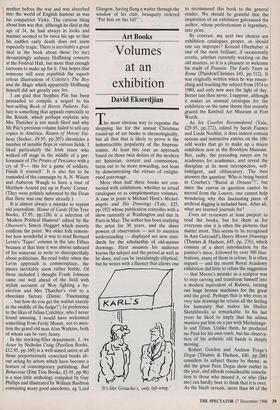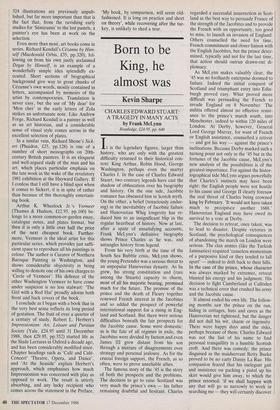Art Books
Volumes at an exhibition
David Ekserdjian
he most obvious way to organise the shopping list for the annual Christmas round-up of art books is chronologically, but all that that is likely to prove is the indestructible popularity of the Impress- ionists. At least this year an approach based on those twin deities of the modern art historian, context and commission, turns out to be more rewarding, not least by demonstrating the virtues of enlight- ened patronage.
More than half these books are con- nected with exhibitions, whether as actual catalogues or as complementary volumes. A case in point is Michael Hirst's Michel- angelo and His Drawings (Yale, £25, pp.192) whose publication coincides with a show currently at Washington and due in Paris in May. The author has been studying the artist for 30 years, and the sheer powers of observation — not to mention understanding — displayed set new stan- dards for the scholarship of old-master drawings. Hirst assumes his audience knows the subject and the period as well as he does, and can be tantalisingly elliptical, but he writes with a fluency that allows one 'It's like Groucho's, only left-wing.' to recommend this book to the general reader. We should be grateful that the inspiration of an exhibition galvanised the author, whose perfectionism is legendary, into print.
By contrast, my next two choices are exhibition catalogues proper, or should one say improper? Konrad Oberhuber is one of the most brilliant, if occasionally erratic, scholars currently working on the old masters, so it is a pleasure to welcome his study of Poussin: The Early Years in Rome (Phaidon/Christies £45, pp.512). It was originally written when he was resear- ching and teaching the subject from 1974 to 1980, and only now sees the light of day. Better late than never, I suppose, although it makes an unusual catalogue for the exhibition on the same theme that recently graced the Kimbell Art Museum at Fort Worth.
As for Courbet Reconsidered (Yale, £29.95, pp.272), edited by Sarah Faunce and Linda Nochlin, it does indeed contain serious and instructive entries on the 100- odd works that go to make up a major exhibition now at the Brooklyn Museum. But, sadly, the preceding essays are by academics for academics, and reveal the discipline at its most introspective, self- indulgent, and obfuscatory. The best answers the question 'Who is being buried in Courbet's "Burial at Ornans"?', but since the canvas in question cannot be moved from the Louvre, one cannot help wondering why this fascinating piece of archival digging is included here. After all, what are learned journals for?
Even art reviewers at least purport to read the books, but for them as for everyone else it is often the pictures that matter most. This seems to be recognised in Ann Garrould's Henry Moore Drawings (Thames & Hudson, £45, pp. 276), which consists of a short introduction by the painter's niece, followed by over 300 illus- trations, many of them in colour. It is often argued — and the recent Royal Academy exhibition did little to refute the suggestion — that Moore's mistake as a sculptor was to stop carving and transform himself into a modern equivalent of Rubens, turning out huge bronze machines for the great and the good. Perhaps that is why even in very late drawings he retains all the feeling for humanity that makes his Shelter Sketchbooks so remarkable. In his last years he liked to imply that his ultima maniera put him on a par with Michelange- lo and Titian. Unlike them, he produced no Pieta for his own tomb, but his observa- tion of his arthritic old hands is deeply moving.
Robert Gordon and Andrew Forge's Degas (Thames & Hudson, £40, pp.288) considers its subject theme by theme, as did the great Paris Degas show earlier in the year, and affords considerable consola- tion to those who missed it, or who (like me) can hardly bear to think that it is over. As the blurb reveals, more than 60 of the 324 illustrations are previously unpub- lished, but far more important than that is the fact that, from the ravishing early studies for 'Semiramis' to the last pastels, a painter's eye has been at work on the selection.
Even more than most, art books come in series. Richard Kendall's Cezanne by Him- self (Macdonald Orbis, £35, pp.320), fol- lowing on from his own justly acclaimed Degas by Himself, is an example of a wonderfully simple idea splendidly ex- ecuted. Short sections of biographical background give way to great chunks of Cezanne's own words, mostly contained in letters, accompanied by memoirs of the artist by contemporaries. Translation is never easy, but the use of 'My dear' for 'Mon cher' in the early letters of Zola strikes an unfortunate note. Like Andrew Forge, Richard Kendall is a painter as well as an art historian, and a considerable sense of visual style comes across in the excellent selection of plates.
In a similar vein, Richard Shone's Sick- ert (Phaidon, £25, pp.128) is one of a number of short monographs on 20th- century British painters. It is an eloquent and well-argued study of the man and his art, which places particular emphasis on the late work in the wake of the revelatory 1981 exhibition at the Hayward Gallery. If I confess that I still have a blind spot when it comes to Sickert, it is in spite of rather than because of this thoroughly entertain- ing book.
Arthur K. Wheelock Jr.'s Vermeer (Thames & Hudson, £12.95, pp.160) be- longs to a more common-or-garden essay, catalogue notes, and plates format, but then it is only a little over half the price of the next cheapest book. Further- more, Vermeer is the ideal artist for this particular series, which provides just suffi- cient space to reproduce all his paintings in colour. The author is Curator of Northern Baroque Painting in Washington, and shows considerable objectivity in being willing to demote one of his own charges to 'Circle of Vermeer'. His defence of the other Washington Vermeer to have come under suspicion is no less stalwart: 'The Girl with a Red Hat' proudly adorns both front and back covers of the book.
I conclude as I began with a book that in the very best sense reflects its long period of gestation. The fruit of over a quarter of a century of study, Robert L. Herbert's Impressionism: Art, Leisure and Parisian Society (Yale, £24.95 until 31 December 1988, then £29.95, pp.352) started life as the Slade Lectures in Oxford a decade ago, and has been considerably modified since. Chapter headings such as 'Café and Café- Concert"Theatre, Opera, and Dance', and 'At the Seaside' explain Herbert's approach, which emphasises how much Impressionism was concerned with play as opposed to work. The result is utterly absorbing, and any lucky recipient who comes across the statement in the Preface, 'My book, by comparison, will seem old- fashioned. It is long on practice and short on theory', while recovering after the tur- key, is unlikely to shed a tear.



























































 Previous page
Previous page